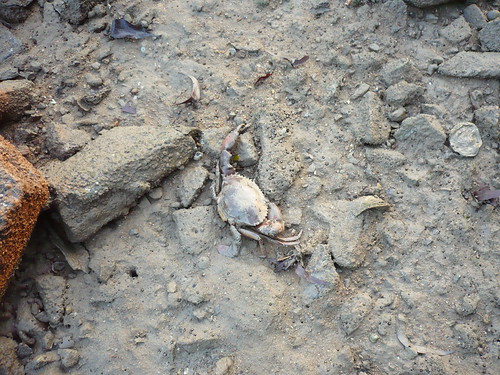
No matter which shore you explore, one is sure to find the dead remains of some sort of animal to examine. Most common of course, are the empty shells of molluscs such as snails and clams, or pieces of dead coral. Dead flower crabs (Portunus pelagicus) can be seen quite often, although chances are that many of these are actually moults.
There were quite a few interesting dead things to look at along this stretch of Changi. And as we'll see later, for some of these animals, there is a very high likelihood that human activity can be implicated in these deaths.
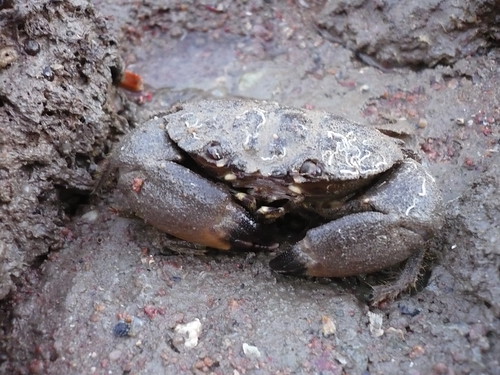
I was wondering why this thunder crab (Myomenippe hardwickii) wasn't reacting to my presence, then I realised that it was quite dead.
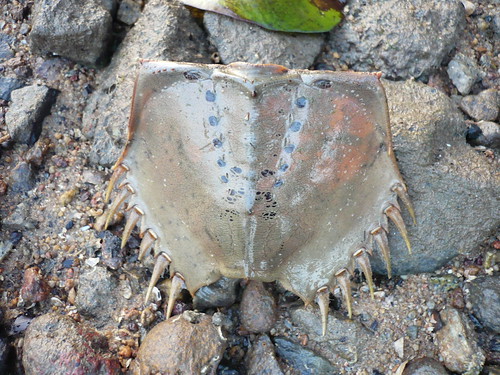
As we slowly made our way back to wash up, I came upon the opisthosoma of a coastal horseshoe crab (Tachypleus gigas). Sigh. I seem to have more luck finding dead horseshoe crabs, when I'm more interested in seeing live ones.
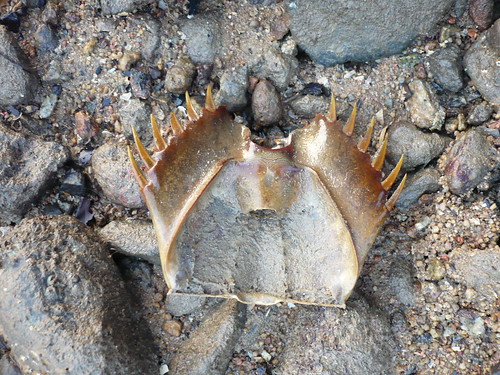
I soon lagged behind, while the others went on ahead. Documenting death can be valuable, as a record of the organisms living in the area.
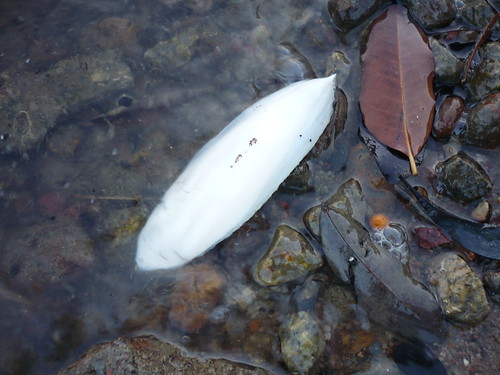
Cuttlebone. Among extant cephalopods, only the nautilus retain an external shell; in cuttlefish and squid, the shell is reduced to a thin internal strip, while the octopus have lost the shell entirely.

The discovery of the day, however, came when I stumbled upon these two large crabs, very dead, very smelly, and covered with flies.
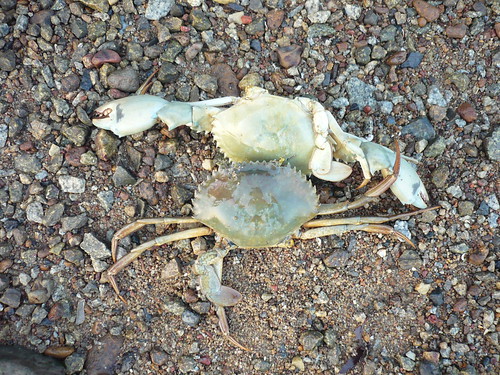
These weren't flower crabs; I flipped them over with my boot, and realised that I was staring at two mud crabs, possibly the green mud crab (Scylla paramamosain)*, and the size of those you'd find for sale in markets and seafood restaurants.
Maybe these were some fisherman's discarded catch, I thought to myself. Further down though, I stumbled upon yet more dead mud crabs.
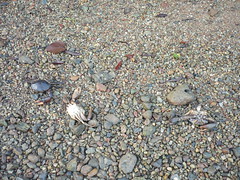
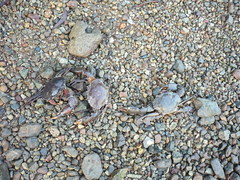
Three of them this time, and based on the coloration, these are purple mud crabs (Scylla tranquebarica)*.

The smell is seriously overwhelming, and the buzzing flies aren't too pleased at having their meal interrupted. The disgusting things I do in the pursuit of my passion for nature.
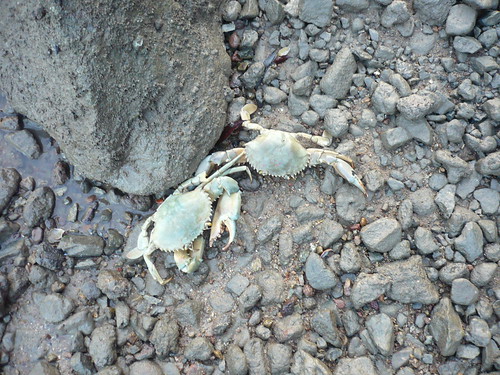
Further down, I found yet more dead crabs!
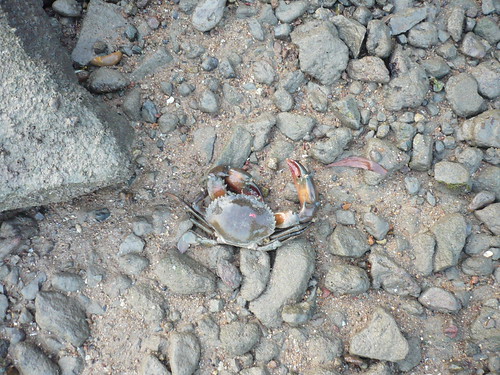
Some of them have a small bright pink mark on the carapace, that looks like it's been painted on. This one is possibly an orange mud crab (Scylla olivacea)*.
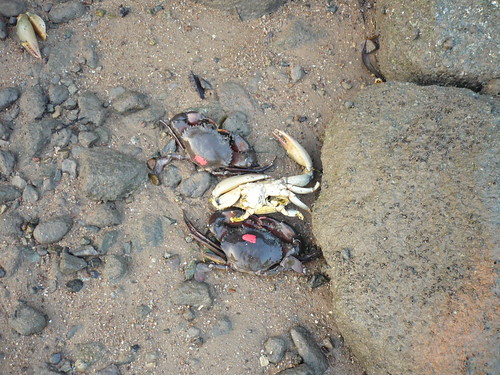
It's like a mud crab graveyard over here!
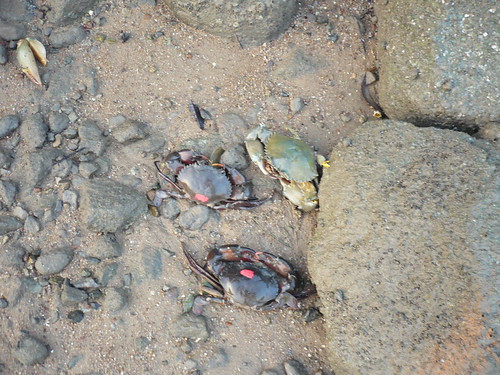
Take note of the pink markings on the two purple mud crabs. And I didn't notice the disembodied pincer on the top left corner of the photo, until I was home and processing the photos.
In all, I found 12 dead mud crabs along a 50 metre stretch of rocky shore! All were good-sized specimens, just like those you can buy at the market.
What could have happened here? Did some fisherman discard his catch? Did a shipment of crabs fall overboard? Is some disease or pollutant killing only mud crabs and nothing else?
When I caught up with Ria, she had a hypothesis of her own to account for this bizarre phenomenon. She thinks that it's very likely that these were released by devotees on Vesak Day, and I agree with her.
Religious merit-making in the form of release of captive animals is often practised on Vesak Day, as a symbolic act of liberation, compassion, and respect for all life. In Singapore and in many other countries in Asia, birds and fish are often released by Buddhist devotees, while turtles and frogs are also popular subjects. Yet, as they say, the road to hell is paved with good intentions.
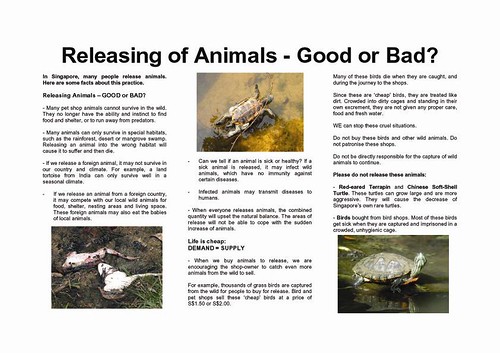
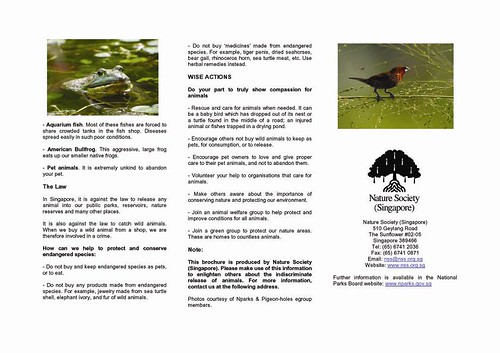
Releasing of Animals - Good or Bad? by the Nature Society (Singapore)
Unfortunately, the people who carry out such practices do not often realise the harm that they cause, in terms of ecological damage from suddenly overwhelming the ecosystem with an influx of released animals, or from introduction of non-native species, such as American bullfrog (Lithobates catesbeianus), red-eared slider (Trachemys scripta elegans), and Chinese softshell turtle (Pelodiscus sinensis), or unwanted aquarium fish.
Not to mention the outright cruelty of not doing any background research, and releasing animals into the wrong habitats! Marcus mentions in this thread:
Some of the dumber cases recently have involved: star tortoises being dumped into the pond at East Coast Park, and freshwater fish like snakeheads being released into the sea.
Good intentions + wilful ignorance = disaster!
Andy has encountered people who tried to release Chinese softshell turtles (which live in freshwater) into the sea at Labrador Park. (I cannot believe that the couple he encountered believed that they were releasing sea turtles! Are people really that ignorant?)
While black-headed munias (Lonchura atricapilla), which are birds of open grassy areas, have been spotted in the forest at Upper Peirce Reservoir, as recorded in this post at the Bird Ecology Study Group, just before Vesak Day.
And often, the animals that are released are in no condition to survive suddenly being thrust into the wild; a sad example is shown here. Unfortunately, if you read the comments in the link provided, you will see a perfect example of how some people still don't understand the cruelty and ecological consequences of such a practice.
Is this the same thing that happened to our mud crabs? There are several pieces of evidence that point to the likelihood that these are the casualties of an ignorant and misguided attempt to give these animals a better life. Most of them point to these crabs being of captive origin, rather than having lived naturally along this shore:
- Mud crabs (Scylla spp.) are native to mangrove and muddy habitats. I've never encountered live mud crabs in the wild before, but I don't think they are found naturally in rocky shore habitats.
- The pink markings found on the carapace of some of these crabs are definitely artificial; it's not as if some pink algae or sponge was encrusting the shells of the crabs. I've seen similar marks on crabs in markets and restaurants, but don't know what they're for. In any case, it's likely that these crabs were captives only until recently, since the pink markings would have been lost the next time the crab moulted.
- The only dead animals visible along this stretch were mud crabs. Pollution would be killing off a much wider variety of creatures.
- These are all crabs of market size. If disease or pollution was killing specifically mud crabs, one would expect a wider range of sizes, from babies to huge adults.
And considering the fact that Vesak Day was just 2 days ago, I think the facts pretty much speak for themselves.
But why mud crabs? Many of the animals released are those destined for the table, so it's no surprise that somebody probably tried to rescue these crabs from the cooking pot, only to condemn them to dying in a habitat they could not survive in. Besides, the other species of crab commonly found in the markets, the flower crab, does not survive for long out of water. The mud crab, being a much hardier species, would be more likely to survive the trip.
I can imagine these crabs having been deprived of food and water for some time in the market, then disoriented from the journey, and then suddenly thrown into the sea in an unfamiliar environment. I doubt they would be in any condition to scuttle off, ready to take on the challenges of surviving in the wild.
Even worse, what if they had been tossed onto the shore at low tide? The crabs hitting the rocks won't exactly improve their chances of survival.
Of course, there is the possibility that this is all just idle speculation, that someone was simply trapping crabs and tossed the unwanted ones. But the fact that the crabs are of captive origin (evidenced from the pink markings, and consistently being of market size), and the proximity to Vesak Day, is just too tantalising to ignore.
Most times, dead animals on the shore provide evidence of the creatures that can be found in the area. Sometimes, however, dead animals can say a lot about the actions of people.
*: These are only tentative identifications, based on the photos of the various Scylla species in A Guide to the Mangroves of Singapore.
This is part 4 of a 4-part series on a trip to Changi on 21st May, 2008.
Part 1: Changi's Hidden Wonders
Part 2: Echinoderm Hangout
Part 3: Do not touch!
Part 4: Death on the shores (this post)